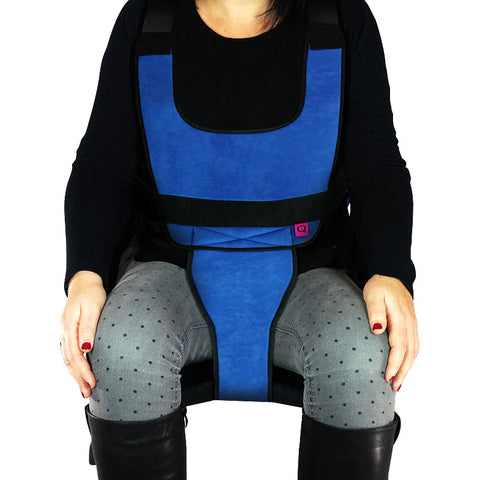Enhancing Mobility and Comfort: The Importance of Vest With Perineal Support for Wheelchair Users
In the world of accessibility and adaptive equipment, innovations continually emerge to improve the lives of individuals with mobility challenges. One such advancement is the Vest With Perineal Support For Wheelchair Users. Designed to enhance both mobility and comfort, this specialized garment offers a range of benefits that can significantly improve the daily lives of those who rely on wheelchairs for mobility. In this article, we'll explore the features, advantages, and importance of vest with perineal support, highlighting its role in promoting independence, stability, and overall well-being.
Understanding the Vest with Perineal Support: The vest with perineal support is a specialized garment specifically designed for individuals with who use wheelchairs. Unlike traditional vests, which primarily focus on upper body support and stability, this innovative garment incorporates additional features to provide support to the perineal area. By offering targeted support in this region, the vest helps to distribute pressure more evenly, reducing the risk of discomfort, skin breakdown, and related complications.
Key Features and Design Elements: A vest with perineal support typically features adjustable straps or harnesses that secure the garment around the user's torso. These straps can be customized to provide a snug and comfortable fit, ensuring optimal support without restricting movement. The perineal support component may consist of padded cushions or inserts strategically positioned to cushion and stabilize the pelvic region.
Additionally, many vests with perineal support are constructed from breathable, moisture-wicking materials to promote airflow and prevent overheating or moisture buildup, which can contribute to skin irritation and discomfort. Some models may also incorporate antimicrobial properties to reduce the risk of bacterial growth and infection.
Benefits of Vest with Perineal Support:
1. Pressure Relief: By distributing pressure more evenly across the torso and pelvic area, the vest with perineal support helps to alleviate pressure points and reduce the risk of pressure ulcers—a common concern for wheelchair users who spend extended periods sitting in one position.
2. Stability and Postural Support: Proper postural alignment is essential for wheelchair users to prevent strain, fatigue, and musculoskeletal issues. The vest with perineal support offers stability and support to the upper body and pelvis, helping users maintain a more ergonomic and comfortable seated position.
3. Enhanced Comfort: The padded cushions and adjustable straps of the vest contribute to a more comfortable experience for the user, minimizing discomfort and promoting greater independence and mobility.
4. Prevention of Falls and Injuries: Falls are a significant risk for wheelchair users, especially when transferring to and from the wheelchair or navigating uneven terrain. The vest with perineal support provides added stability and security, reducing the likelihood of falls and associated injuries.
5. Improved Confidence and Independence: By providing reliable support and stability, the vest with perineal support empowers users to engage in daily activities with greater confidence and independence. Whether navigating their home, workplace, or community spaces, users can enjoy greater freedom and mobility with the assistance of this specialized garment.
Importance in Healthcare and Rehabilitation: In the healthcare and rehabilitation settings, vest with perineal support plays a vital role in promoting the well-being and independence of individuals with mobility challenges or Severe Physical Disabilities. Occupational therapists, physical therapists, and other healthcare professionals may recommend the use of this specialized garment as part of a comprehensive care plan for wheelchair users.
During rehabilitation, the vest with perineal support can aid in improving posture, balance, and core strength, facilitating the user's transition to independent mobility. Healthcare providers may also prescribe the vest to prevent complications such as pressure ulcers and musculoskeletal issues, particularly for individuals with limited mobility or sensation.
Moreover, the vest with perineal support can enhance the effectiveness of other mobility aids and assistive devices, such as wheelchairs, walkers, and standing frames. By providing consistent support and stability, the vest complements these devices, enabling users to achieve greater functionality and mobility in their daily lives.
Challenges and Considerations: While the vest with perineal support offers numerous benefits, there are some challenges and considerations to keep in mind.
1. Individualized Fit: Proper fitting is crucial to ensure the effectiveness and comfort of the vest. Healthcare professionals may need to assess each user's unique anatomy and mobility needs to select the most suitable size and configuration.
2. Cost and Accessibility: Like many specialized healthcare products, vests with perineal support may be costly, making them inaccessible to some individuals who could benefit from them. Addressing affordability and insurance coverage challenges is essential to ensure equitable access to these important assistive devices.
3. User Comfort and Preferences: While the vest with perineal support is designed for comfort, individual preferences and sensory sensitivities may vary. Users should have the opportunity to provide feedback and make adjustments to ensure the garment meets their needs and preferences.
Conclusion: In conclusion, the vest with perineal support is a valuable assistive device that enhances mobility, comfort, and overall well-being for wheelchair users. By providing targeted support to the torso and pelvic region, this specialized garment helps to alleviate pressure, promote stability, and reduce the risk of complications such as pressure ulcers and falls. Incorporating features such as adjustable straps, breathable materials, and ergonomic design elements, the vest offers a practical solution for individuals seeking to improve their independence and quality of life. Moving forward, continued innovation, research, and advocacy are essential to ensure that vests with perineal support remain accessible and beneficial to all who need them in the wheelchair user community.
Sample Block Quote
Praesent vestibulum congue tellus at fringilla. Curabitur vitae semper sem, eu convallis est. Cras felis nunc commodo loremous convallis vitae interdum non nisl. Maecenas ac est sit amet augue pharetra convallis nec danos.
Sample Paragraph Text
Praesent vestibulum congue tellus at fringilla. Curabitur vitae semper sem, eu convallis est. Cras felis nunc commodo eu convallis vitae interdum non nisl. Maecenas ac est sit amet augue pharetra convallis nec danos dui.
Cras suscipit quam et turpis eleifend vitae malesuada magna congue. Damus id ullamcorper neque. Sed vitae mi a mi pretium aliquet ac sed elitos. Pellentesque nulla eros accumsan quis justo at tincidunt lobortis denimes loremous. Suspendisse vestibulum lectus in lectus volutpat, ut dapibus purus pulvinar. Vestibulum sit amet auctor ipsum.

